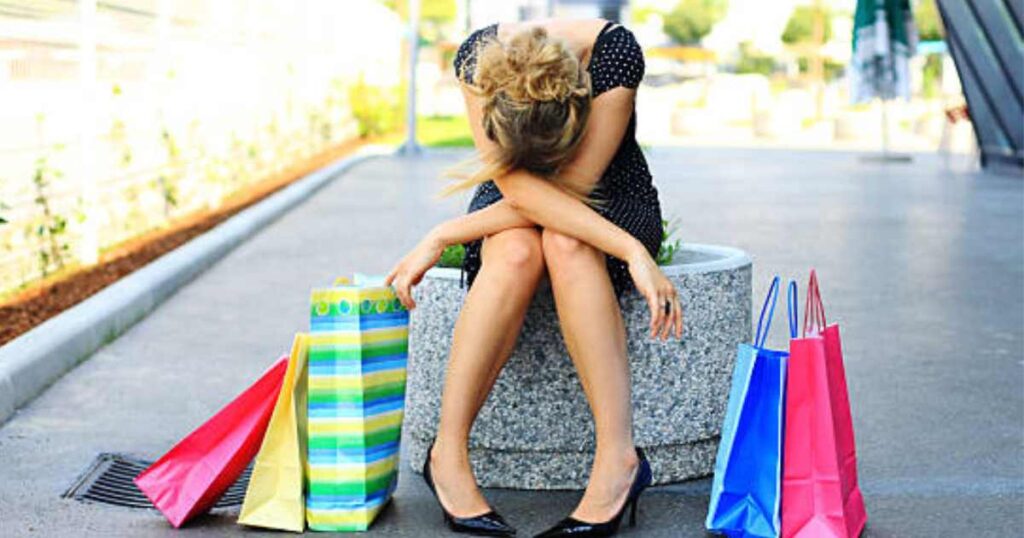In today’s consumer-driven society, shopping has become more than just a necessity. And, it’s often seen as a form of leisure, a means of self-expression, and even a form of therapy for some. However, for individuals struggling with compulsive shopping disorder, this seemingly harmless activity can spiral out of control, wreaking havoc on their finances, relationships, and overall well-being. In this blog, we delve into the negative impacts of compulsive shopping disorder, exploring its causes, symptoms, and potential avenues for recovery.
Contents
What Are the Causes of Compulsive Shopping?
 Compulsive shopping disorder or shopping addiction, is a complex condition influenced by a variety of factors. Here are some common causes:
Compulsive shopping disorder or shopping addiction, is a complex condition influenced by a variety of factors. Here are some common causes:
- Psychological Factors
Underlying psychological issues such as low self-esteem, depression, anxiety, or unresolved emotional trauma can contribute to compulsive shopping. Shopping may serve as a coping mechanism to alleviate negative feelings or fill a void in one’s life.
- Impulse Control
Individuals with poor impulse control may find it difficult to resist the urge to shop excessively. Even when they know it’s detrimental to their financial or emotional well-being. This lack of self-regulation can fuel compulsive buying behaviors.
- Social and Cultural Influences
Societal pressures to conform to certain standards of appearance, status, or success can drive compulsive shopping. Advertisements, social media, and peer influence can create a sense of inadequacy or the need to constantly acquire new possessions.
- Genetics and Brain Chemistry
Some research suggests that there may be a genetic predisposition to compulsive shopping, and certain brain chemicals, such as dopamine. These are involved in the brain’s reward system and may play a role in reinforcing shopping behaviors.
- Past Experiences
Previous positive experiences associated with shopping, such as the thrill of finding a bargain or the temporary relief of stress, can create a pattern of behavior that becomes difficult to break, leading to compulsive shopping tendencies.
- Accessibility and Technology
The ease of online shopping and the prevalence of credit cards and digital payment methods have made it more convenient than ever to shop impulsively. The constant availability of shopping opportunities can exacerbate compulsive buying behaviors.
Understanding these potential causes can be the first step toward addressing compulsive shopping behaviors and seeking appropriate support and treatment.
What Are The Symptoms To Identify?
Identifying symptoms of compulsive shopping disorder can help individuals recognize when their shopping habits have become problematic. Here are some common symptoms to look out for:
- Preoccupation with Shopping: Constantly thinking about shopping, planning future purchases, or feeling restless when unable to shop.
- Compulsive Buying Episodes: Engaging in frequent and excessive shopping sprees, often resulting in the purchase of items that are unnecessary, unaffordable, or unwanted.
- Loss of Control: Difficulty controlling or resisting the urge to shop. Even when it leads to negative consequences such as financial problems, relationship conflicts, or emotional distress.
- Shopping as a Coping Mechanism: Using shopping as a way to escape from negative emotions, relieve stress, or boost mood temporarily.
- Feelings of Guilt or Shame: Experiencing guilt, shame, or regret after shopping episodes, especially when they result in financial hardship or conflict with loved ones.
- Concealing or Denying Shopping Habits: Hiding purchases, lying about the extent of shopping behavior, or minimizing the impact of compulsive buying on one’s life.
- Interference with Daily Life: Neglecting responsibilities, hobbies, or relationships in favor of shopping or spending excessive time browsing online retailers.
- Failed Attempts to Cut Back: Making repeated attempts to control or reduce shopping habits but struggling to maintain long-term changes.
- Hoarding Behavior: Accumulating large quantities of items, often with little regard for their practical use or value. And, leads to clutter and disorganization in living spaces.
If you or someone you know is exhibiting several of these symptoms and experiencing distress in daily functioning as a result of compulsive shopping, it may be beneficial to seek professional help.
What Are the Dangers of Compulsive Buying?
 Compulsive buying, like any addiction, can have significant negative consequences on various aspects of a person’s life. Some of the dangers associated with compulsive buying include:
Compulsive buying, like any addiction, can have significant negative consequences on various aspects of a person’s life. Some of the dangers associated with compulsive buying include:
1. Financial Problems
Compulsive buying often leads to overspending, accumulating debt, and financial instability. Individuals may max out credit cards, take out loans, or deplete savings to fund their shopping habits. And, resulting in long-term financial consequences.
2. Relationship Strain
Compulsive buying can strain relationships with family members, friends, and significant others. Conflicts may arise over financial disagreements, dishonesty about spending habits, or neglect of shared responsibilities.
3. Emotional Distress
Compulsive buying can exacerbate feelings of guilt, shame, anxiety, and depression. Individuals may experience emotional distress related to their inability to control their spending. Hence, resulting in negative self-perception and decreased overall well-being.
4. Decline in Productivity
Excessive time spent shopping or thinking about shopping can detract from productivity at work or school. Compulsive buyers may neglect important tasks, miss deadlines, or experience difficulties concentrating due to their preoccupation with acquiring new possessions.
5. Clutter and Disorganization
Compulsive buying often leads to the accumulation of unnecessary items, resulting in clutter and disorganization in living spaces. This can create physical and psychological distress, as individuals may feel overwhelmed by the chaos and unable to find peace in their environment.
6. Health Risks
Compulsive buying can contribute to stress-related health problems, such as insomnia, headaches, digestive issues, and compromised immune function. Chronic stress associated with financial difficulties and interpersonal conflicts can also increase the risk of developing chronic diseases over time.
Overall, compulsive buying can have far-reaching and profound negative impacts on individuals’ lives, affecting their financial stability, relationships, emotional well-being, and overall quality of life.
How To Manage Compulsive Shopping Disorder?
 Managing compulsive shopping disorder involves a combination of self-help strategies, professional intervention, and support from loved ones.
Managing compulsive shopping disorder involves a combination of self-help strategies, professional intervention, and support from loved ones.
Practical tips
Here are some steps individuals can take to manage their compulsive shopping behaviors:
Identify Triggers and Underlying Issues
Understanding the underlying triggers and emotional drivers behind compulsive shopping is crucial for effective management. Triggers can vary widely from stress and anxiety to feelings of inadequacy or boredom. By identifying these triggers and exploring the deeper emotional issues, individuals can develop targeted coping strategies to address them.
Develop Coping Strategies
Once triggers and underlying issues are identified, it’s essential to develop healthy coping strategies to manage them effectively. This might include practicing relaxation techniques like deep breathing or meditation to alleviate stress, finding alternative ways to address emotional needs, or engaging in activities that provide a sense of fulfillment and satisfaction outside of shopping.
Set Limits and Budget
Setting clear limits and boundaries around spending is essential for managing compulsive shopping. This might involve creating a budget for discretionary spending, tracking expenses, and sticking to predetermined limits. Avoiding situations or environments that trigger impulsive spending and planning purchases in advance can also help individuals stay within their budgetary constraints.
Delay Gratification
Practicing delayed gratification can be an effective strategy for curbing impulsive shopping tendencies. Rather than giving in to immediate impulses, individuals can implement a “cooling-off” period before making any non-essential purchases. This allows time for reflection and consideration. Thus, helping to distinguish between genuine needs and impulsive wants.
Practice Mindful Shopping
Approaching shopping mindfully involves being aware of one’s thoughts, feelings, and impulses while shopping. This includes questioning the motives behind purchases, considering their alignment with personal values and priorities, and evaluating the long-term consequences of buying decisions. Mindful shopping empowers individuals to make more intentional and conscious choices.
Seek Professional Help
Seeking professional help from a therapist, counselor, or support group specializing in addiction and compulsive behaviors can provide valuable support. Also, guidance in managing compulsive shopping disorders. Therapy can help individuals gain deeper insights into the underlying causes of their shopping habits, develop effective coping strategies, and address any co-occurring mental health issues contributing to the problem.
Involve Supportive Others
Sharing struggles with trusted friends, family members, or support groups can provide much-needed encouragement, accountability, and understanding. Open communication and seeking support from loved ones create a sense of connection and solidarity, reducing feelings of isolation and empowering individuals in their recovery journey.
Practice Self-Compassion
Managing compulsive shopping disorder is a challenging process that may involve setbacks and relapses along the way. Individuals need to practice self-compassion and kindness towards themselves throughout the journey. This includes acknowledging progress, celebrating successes, and being patient and understanding during difficult times.
Managing compulsive shopping disorder requires commitment, self-awareness, and a willingness to seek help when needed. By implementing these strategies and seeking support from professionals and loved ones, individuals can take control of their shopping behaviors and work towards a healthier, more balanced lifestyle.
Conclusion
In conclusion, managing compulsive shopping disorder requires a multifaceted approach that combines self-awareness, proactive strategies, and support from professionals and loved ones. By recognizing the problem, identifying triggers, and developing healthy coping mechanisms, individuals can regain control over their shopping behaviors and mitigate the negative consequences.
While the road may be challenging and setbacks may occur, practicing self-compassion and persistence can empower individuals to overcome compulsive shopping and lead a healthier, more balanced lifestyle. Remember, recovery is possible with dedication, support, and a commitment to self-improvement.
